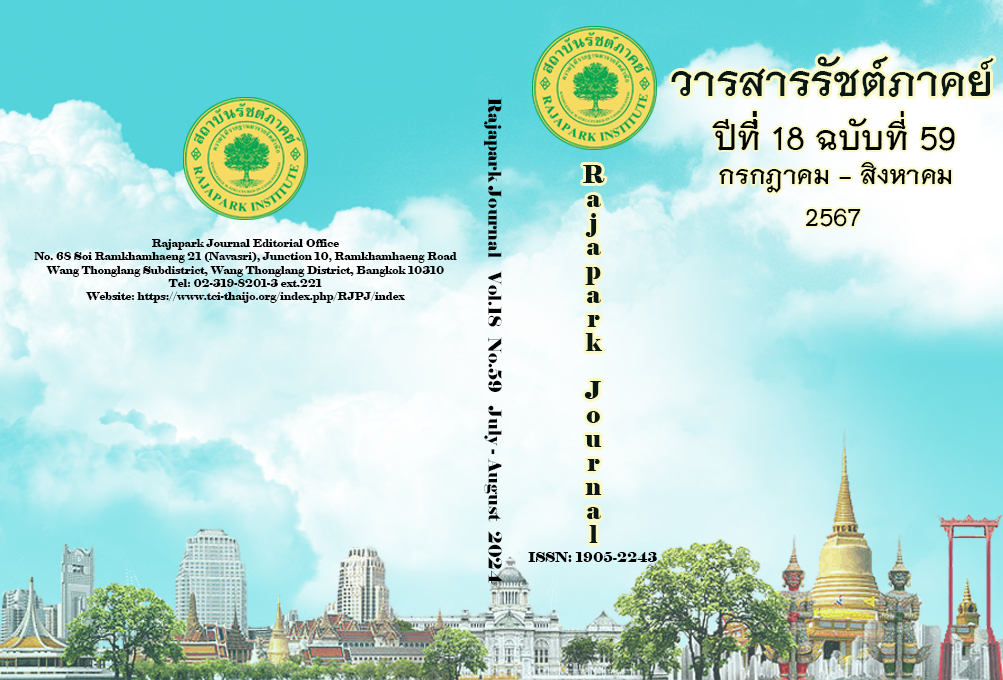Guidelines for Adaptation of Ecotourism Logistics Businesses in Phra Nakhon Sri Ayutthaya Historical Park during Crisis
Main Article Content
Abstract
The objectives of this research were 1) to examine the operations of ecotourism logistics businesses (ELB) in Phra Nakhon Sri Ayutthaya Historical Park, 2) to examine the factors of guidelines for adaptation of ELB, and 3) to develop a structural equation model of guidelines for adaptation of ELB. The sampling group consisted of ELB in Phra Nakhon Sri Ayutthaya Historical Park. The size of the sampling group was determined through cluster sampling and systematic random sampling methods. The qualitative research tool was an in-depth interview for analysis and a summary of guidelines for the adaptation of ELB to each factor. The quantitative research tool was a survey, and the data were analyzed using SPSS and AMOS. The research results were as follows: 1) The operations with the highest score were as follows: 1.1) tourism training businesses in partnership with governmental sectors; 1.2) public health safety standards certification through public health organizations; 1.3) public health safety standards participation for recognition; 1.4) promoting local authorities for innovation; 1.5) public health safety tools to support tourism; 1.6) Information Technology as a communication channel; 1.7) Information Technology for sales promotion; 1.8) Information Technology management to improve tourism; 1.9) publicity through social media. 2) There were 4 research factors as follows: 2.1) partnership ( = 4.15); 2.2 certification (
= 4.15); 2.3 innovation (
= 4.13); 2.4 Information Technology (
= 4.10); and 3) The analysis of structural equation modeling met the criteria. It was consistent with the empirical data (Chi-square value (χ2) of NN, degree of freedom (df) of NN, p-value of 0.128, relative chi-square χ2/df of 1.119, goodness of fit (GFI) of 0.962 and root mean square residual (RMR) of 0.015.
Article Details

This work is licensed under a Creative Commons Attribution-NonCommercial-NoDerivatives 4.0 International License.
Views and opinions appearing in the Journal it is the responsibility of the author of the article, and does not constitute the view and responsibility of the editorial team.
References
Arbuckle, J. L. (2016). AMOS 20.0 users guide. Crawfordville, FL: Amos Development Corporation.
Ayutthaya Provincial Office of Tourism and Sports. (2021, May 16). Phra Nakhon Si Ayutthaya tourist attractions. https://ayutthaya.mots.go.th/more_news.php?cid=17
Badran, B., & Badran, N. B. (2019). Strategic networks and alliances among tourism MSMEs: The case of Dubai’s “Wander With”. Piccola Impresa Small Business, (1). https://doi.org/10.14596/pisb.313
Bank of Thailand. (2021, May 12). Tourism and its role in driving the Thai economy Is a hero necessary? A real hero?. https://www.bot.or.th/content/dam/bot/documents/en/our-roles/monetary-policy/mpc-publication/monetary-policy-report/mpr-box/MPR_2023_Q4_BOX1.pdf
Fill, C., & Turnbull, S. (2016). Marketing communications: Discovery, creation and conversations (7th ed.). Pearson Education.
Gössling, S. (2021). Tourism, technology and ICT: A critical review of affordances and concessions. Journal of Sustainable Tourism, 29(5), 733-750. https://doi.org/10.1080/09669582.2021.1873353
Khampan, B., & Khuna, Y. (2018). Conseling for adolescent in critical situation in Maerim District Chiang Mai Province. The National & International Conference. Graduate Studies in Northern Rajabhat University 18th and Lampang Research 4th (pp. 208-228).
Krungsri Research. (2021, March 6). Tourism and hotel business after COVID-19. https://www.krungsri.com/th/research/research-intelligence/ri-future-of-tourism-21
Kulprayeepunya, K., & Amornchai, R. (2013). Accreditation and certification: Value-oriented evaluation from theory to practice. Nursing Journal of The Ministry of Public Health, 23(2), 11–19. https://he02.tci-thaijo.org/index.php/tnaph/article/view/11887
Lamb, C. W., Hair, J. F., & McDaniel, C. (2009). Essentials of marketing (6th ed.). Calhoun Publisher.
Li, Z., Wang, D., Abbas, J., Hassan, S., & Mubeen, R. (2022). Tourists’ health risk threats amid COVID-19 era: role of technology innovation, transformation, and recovery implications for sustainable tourism. Frontiers in Psychology, 12, 769175. https://doi.org/10.3389/fpsyg.2021.769175
Illiyyina, I., Rahmi, F. A., Lesmana, R. H., & Kriswibowo, A. (2021). Analysis of public trust toward Cleanliness, Health, Safety, and Environmental Sustainability (CHSE) certification policy in Surabaya City. Journal of Local Government Issues, 4(2), 121-135.
DOI: 10.22219/logos.v4i2.16742
Ministry of Tourism and Sport. (2021, May 12). Number of foreign tourists traveling to Thailand in the past 20 years. https://www.mots.go.th/news/category/704
Ministry of Tourism and Sport. (2022, January 12). Thailand Tourism Standard. https://secretary.mots.go.th/strategy/more_news.php?cid=3
Phongphiriyakarn, J. (2021, September 16). The influence of business alliance type on brand equity a case study of developing the business alliance between credit card and restaurant business in Bangkok and surrounding areas. http://dspace.bu.ac.th/bitstream/123456789/479/3/jadsada_thon.pdf
Phuangphet, S. (2018). Satisfaction of logistics system of tourist attraction in Prachuap Khiri Khan Province[Master’s Thesis, Sripatum University]. http://dspace.spu.ac.th/handle/123456789/6626
Ranong, L. (2017). Theory and practice of Gestalt counseling. Concepts of Guidance & Theory in Phychological Counseling (257111). Unit 6. School of Educational Studies, Sukhothai Thammathirat Open University.
Rattanamanee, N., Kittisaknawin, Ch. & Deesawadi, N. (2018). Organization Development Through Strategic Alliance. Journal of Humanities and Social Sciences Thonburi University, 12(27), 175–186. https://so03.tci-thaijo.org/index.php/trujournal/article/view/110430
Scheyvens, R., & Cheer, J. M. (2022). Tourism, the SDGs and partnerships. Journal of Sustainable Tourism, 30(10), 2271-2281. https://doi.org/10.1080/09669582.2021.1982953
Schilling, M. A. (2016). Strategic management of technological innovation (5th ed.). McGraw-Hill.
Silpcharu, T. (2020). Research and analysis of statistical data with SPSS and AMOS (18th ed.). SR Printing Mass Products.
Supeno, I., Mudana, I. G., & Murni, N. G. N. S. (2021). THE CHSE (Cleanliness, Health, Safety, and Environment) Program for New Normal Life in Tijili Benoa Curated Artotel. International Journal of Glocal Tourism, 2(3), 137-145. DOI: https://doi.org/10.58982/injogt.v2i3.69
Tijani, A.A., Osagie, R.O., & Afolabi, B.K. (2021). Effect of strategic alliance and partnership on the survival of MSMEs post COVID-19 pandemic. Ekonomicko-manazerske spektrum, 15(2), 126-137. dx.doi.org/10.26552/ems.2021.2.126-137
Tipsri, N., Chiatrakul, K., ….. & et al. (2015). Tourism logistic management of travel business in Chiang Rai. Journal of Thai Hospitality and Tourism, 10(2), 60-70. https://so04.tci-thaijo.org/index.php/tourismtaat/article/view/45402
Tourism Authority of Thailand. (2020, January 9). Phra Nakhon Sri Ayutthaya. https://www.tourismthailand.org/Destinations/Provinces/Phra-Nakhon-Si-Ayutthaya/229
Waewklaihong, O. (2022). Tourism management and tourism logistics to increase the competitiveness in Thailand’s tourism industry[Master’s thesis, National Institute of Development Administration].
Wichatorn, K. (2021, September 16). What is information? How important is it to learning?. https://www.gotoknow.org/posts/376670.
Wilhite, T. (2022, September 6). Peter Drucker’s 7 sources of opportunity for business. Toughnickel. https://toughnickel.com/business/The-Seven-Sources-of-Opportunity-for-Businesses-per-Drucker


